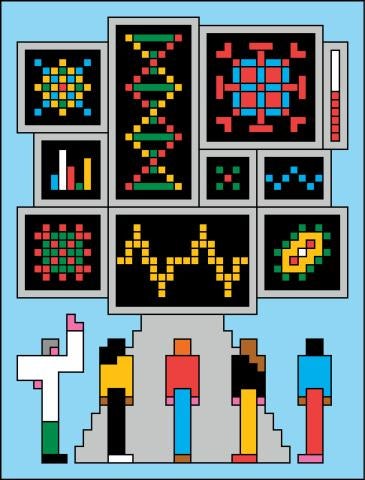With AI, we can … Improve the ways products are made and factories operate
Photo: A CWRU team helped bring AI-driven instruments to this Cleveland photovoltaic power plant and analyze its output.
Call it a new industrial revolution: The factories that make everything from solar panels to jet engines are increasingly decked out with sensors, augmented by computer-controlled machines and data streaming to the cloud.
Now, Case Western Reserve University engineering faculty are part of efforts to use artificial intelligence to help “smart factories” become even smarter by uncovering ways to reduce waste and save energy, anticipating equipment breakdowns and scrutinizing how materials perform at every stage of production and usage over their lifetime.
But to realize AI’s full potential for materials science and manufacturing, these machines, as well as the researchers who study them and engineers who build them, will need to speak a common language. And CWRU engineering professor Roger French is helping to write its rules.
“We want to make data findable, accessible, interoperable and reusable,” said French, PhD, a Distinguished University Professor and the Kyocera Professor of Ceramics. The acronym is “FAIR” and the approach is the foundation for sharing information in materials data science. To achieve that, French spearheaded the creation of a new open-source lexicon, called an ontology, for materials scientists, engineers and manufacturers.
“Ontology is a shared dictionary,” said French, but not just a dictionary. “It also defines the relationship between words.” In doing so, it allows researchers to use AI to make—and justify—scientific inferences based on data from different papers, instruments and labs.
French and his students are using the ontology in their own research, which includes examining how photovoltaics perform over time. French co-launched the university’s SDLE Research Center in 2011 and now leads projects funded by the U.S. Department of Energy to make solar panels last longer and model how the performance at groups of photovoltaic power plants deteriorates over time. The center also helped launch Edifice Analytics, a startup that offers virtual energy audits of buildings.
With a $14.2 million grant from the U.S. Department of Energy’s National Nuclear Security Administration (NNSA), French is also applying the ontology to help the NNSA harness insights from AI to keep its nuclear stockpile safe and secure. “We now have a number of projects in which this would help them find defects, certify parts and make better parts quicker,” French said.
Meanwhile, Robert Gao, PhD, the Cady Staley Professor and chair of CWRU’s Department of Mechanical and Aerospace Engineering, has been leading a National Science Foundation (NSF)-sponsored research initiative. The aim is to help small- and medium-sized local manufacturers—which Gao said account for 98% of manufacturers in Cuyahoga County and nearly 70,000 workers—gain access to the fruits of AI.
“The manufacturing community can advance by taking advantage of AI.” —Robert Gao, professor of engineering
But unlike global giants, smaller manufacturers typically don’t have the resources to invest in digital manufacturing enabled by AI, and they don’t have the luxury of shutting down production to install new sensors on older equipment, he said. In the future, he hopes to create a demonstration lab that could help local manufacturers become more familiar with AI-enabled manufacturing by seeing it in action.
Gao is also working to promote new manufacturing technology by demonstrating it first on an AI-powered “digital twin,” or virtual model, of the physical equipment. As part of the multi-university NSF-funded HAMMER (Hybrid Autonomous Manufacturing, Moving from Evolution to Revolution) Engineering Research Center, led by The Ohio State University, Gao has teamed up with engineers and AI specialists to create a platform for robots to learn how to accurately bend and twist metal plates that surgeons use to mend broken jaws. Historically, surgeons shape these plates by hand to match each patient’s anatomy. Gao and his colleagues envision a robot doing the job more quickly and precisely than a human surgeon.
As he looks to the future, Gao recognizes that manufacturing AI has the potential to transform the workforce and change workers’ lives. While the losses of certain job functions are possible, Gao hopes AI will ultimately make human labor safer and more efficient. “We’re talking about having AI help us human beings work with a lighter load on our backs,” he said.
Photograph courtesy of SDLE Research Center at CWRU
Research Impact


